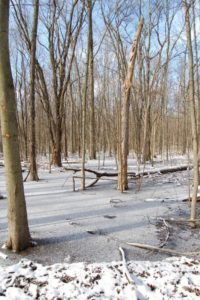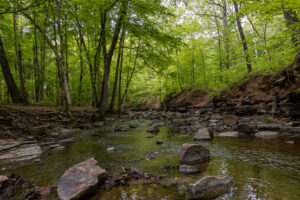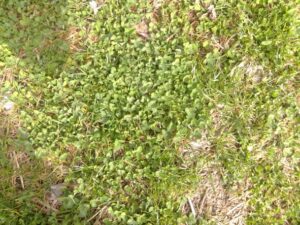 By Saundra McBrearty, Outreach and Volunteer Specialist
By Saundra McBrearty, Outreach and Volunteer Specialist
I savor fresh smells of thawing snow seeping into the ground as temperatures zigzag back and forth over the freezing point of water. I’m bundled up in my winter coat, but smell spring in the air as I hike the Acorn Trail at Gallant Woods Park. I notice pools of melt water flooding low areas on the forest floor. These small wetlands in the forest and field become the vernal pools of spring.
Vernal pools are not connected to streams, and their power is in the fact that they dry up, eliminating the ability for fish and other aquatic predators to survive. Amphibians and other organisms find relative safety in vernal pools and can complete their life cycle, in spite of an existing complex food web.
Vernal pools flourish with a diverse collection of organisms. Invertebrates, crustaceans, mollusks, amphibians, reptiles, birds, and mammals benefit from vernal pools. Some, in fact, would not exist without vernal pools.
Biologists classify animals that benefit from vernal pools in two categories: obligate species and facultative species. Obligate species are organisms completely dependent on vernal pools for parts of their lifecycles. Blue spotted salamanders, spotted salamanders, and Jefferson salamanders – as well as wood frogs and the crustaceans known as fairy shrimp – are examples of obligate species that require vernal pools to breed and survive. When obligate species are present, the habitat is classified as a vernal pool. Without vernal pools, these obligate species cannot survive.
Facultative species take advantage of the lush vernal pool environment, but are able to breed, forage, and fulfill their life cycle elsewhere if needed. These animals are part of an intricate food web preying on one another. Larvae of dragonfly, damselfly and caddisfly grow in the vernal pool and indicate a healthy aquatic environment. But herons, geese, and ducks eat these young invertebrates and feed on fresh plants in and around vernal pools. Turtles and snakes also eat the larvae and prey on fairy shrimp and fingernail clams. Deer, raccoon, and mice visit vernal pools to bath, drink and feed on plants, amphibians, and crustaceans.
I spot fresh deer tracks crossing the muddy trail that leads toward the vernal pool and hear the honking of geese in formation overhead. A hint of spring is in the air, and although it is early yet for breeding salamanders to migrate to the pool, the scent brings hope for the exciting awakening ahead.
Want to experience a vernal pool firsthand? Explore this fascinating habitat with a naturalist at Gallant Woods Park on Saturday, March 17 at 10 a.m. (Free; ages 5 and older). Mark your calendar, pull on your waterproof boots and join us!








